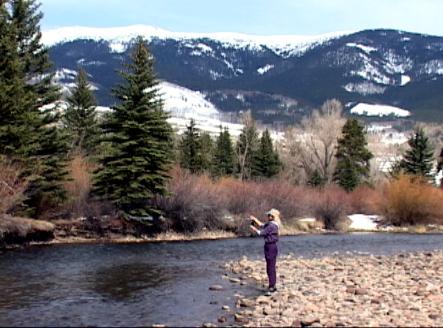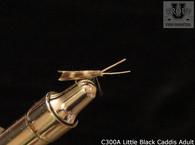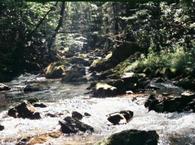
The Blue River starts only about 60 miles from Denver Colorado and passes the famous ski slope of Breckenridge. It is from 80 to 100 feet across as it flows through the Gore Mountains on its way to meet the Colorado River near Kremmling Colorado. The Blue River has a stretch that carries the designation of “Gold Medal” which is catch and release to protect the population of huge rainbows. Be sure check the regulations that pertain to that designation.
The Blue is a medium-size river, running 100-300 cfs most years, and one of the most scenic Gold Medal fisheries in Colorado. A twenty mile stretch from Dillon Reservoir to Green Mountain Reservoir offers the best chance for success with the first few miles below the Dillon Dam being the most productive due to the Mysis shrimp. Much of the other water is private, so most anglers use the ten miles of public access between the two lakes. Large boulders, large river bends and deep pools in the river present a variety of seams and provides excellent holding habitat for the trout.
Despite the angling pressure enjoyed by the Blue River the trout population remains excellent due to the food source of the Mysis shrimp. These shrimp thrive in the Dillon Reservoir and manage to escapes the impoundment to provide ample food for the huge trout. The average rainbow will be around 16 inches and occasionally a rainbow as large as ten pounds can be taken from the Blue River.
The 10 miles of the Blue River above the Dillon Reservoir can not be overlooked. It is a freestone fishery consisting of trout averaging 12 to 14 inches in length. This water like most small freestone streams is characterized by deep runs, pools and riffles.
Fly Fishing the Blue River:
The methods and the techniques to fish the Blue River depend on the species and the seasons. The species are Brown, rainbow, some brook trout, cutthroats and fall spawning Kokanee salmon. If you fish for the giant trout gorging themselves on the Mysis Shrimp escaping from the dam, concentrate on the couple of miles below the dam. Use mysis shrimp patterns like the Stalcup’s mysis shrimp in hook sizes 16 and 18.
Around Silverthorne, the Blue River can be shopped from the pavement around the shopping center and there some of the biggest trout caught fright there. However, to fish there, for those large trout, you will have to give up the great scenery that is available elsewhere on the Blue.
The upper water above the dam is one of the few places where a dry fly will be the most effective and light tackle will be in order. In other sections, nymphs will be more effective and heavier tackle will be a benefit.
Spring:
The tailwater will remain a constant temperature allowing fishing all year long. The blue winged olives begin to hatch in March and April and midges, minnows and mysis shrimp patterns will prevail.
Summer:
Summer is a great time for fly fishing Blue River due to the cold water starting around the first of June the discharges are usually increased to allow for the melting snow. Hatches of Green Drakes, Dark Red Quills, Pale Morning Duns, several species of caddisflies and some stoneflies occur mostly on the lower sections of the river. Dry fly action usually gets good around the middle of July.
Fall:
Large brown trout and Kokanee Salmon move out of Blue Mountain Reservoir upstream into the Blue River to
spawn in the fall. This is a good time to catch some nice browns and engage in battle with th Kokanee Salmon. Nymphs and streamers will most like be the most effective for the salmon during the spawning run
Winter:
Low winter discharges provides excellent fishing all winter long. The second brood of the blue winged olives as well as midges will be the aquatic insect hatches in late fall and early winter. Later in winter switch to the mysis, and minnow imitations.
The entire length of the Blue River is paralleled by Route 9 to provide plenty of good access.
View Western USA in a larger map





